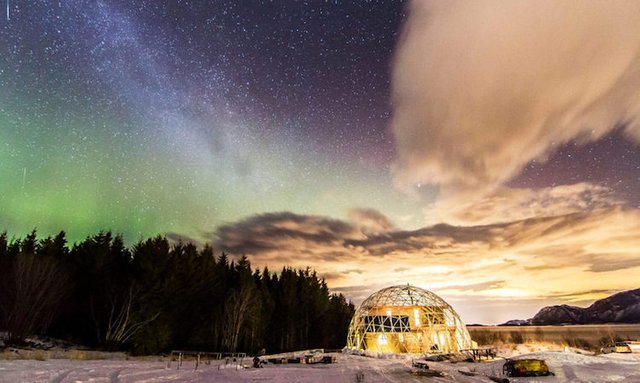
As cities across the planet continue to grow, our willingness to work with nature and create spaces that welcome local plants and wildlife must improve. Today, offices and homes are being designed to be more energy-efficient, ecological and sustainable. Cities like Singapore and Montreal, for example, have been building gardens into the city's buildings in order to attract local wildlife.
As more and more projects like these take shape, it is hoped that all architectural designs of the future will focus on sustainability and their ecological impact. In the meantime, a number of individual families and companies have been leading the way into the future with some extraordinary designs that are both ecological and energy-efficient.
One such family is the Hjertefølger family, who built a 3-story cob house in Norway’s Sandhornøya island. The house, which is built from sand, water, clay, and other organic materials, has been home to the family since 2013.
The house is encased in a functional, 25-foot-high solar geodesic dome by Solardome, which helps the five-bedroom, two-bathroom house withstand the extreme weather conditions typical of the Arctic Circle.
“The feeling we get as we walk into this house is something different from walking in to any other house,” Hjertefølger shares. “The atmosphere is unique. The house has a calmness; I can almost hear the stillness. It is hard to explain. But it would have been impossible getting this feeling from a house someone else has planned and built for us, or a house with corners and straight lines.”
In addition to protecting the house, the dome also provides the family with the perfect greenhouse environment to growing much of their food in their garden. Apples, cherries, plums, apricots, kiwis, grapes, cucumbers, tomatoes, herbs, squash, and melons are just some of the many fruits and vegetables grown by the family – impressive, considering they are located in an area that is without sunlight for three months a year.
While they are incredibly happy in their eco-friendly abode, the family is already thinking of ways to improve the original design of the Nature House. “If we were to build a new Nature House, the ideal thing would be double glass on the green house so that we could have a tropical garden and no dripping in the winter,” said Hjertefølger. “But that is a bit unrealistic because it is very expensive with all that glass.”
The interior of the property has been designed to embody nature, with a rustic wooden staircase and ceiling beams. This creates a warm and cozy atmosphere that is protected from the Arctic Circle's cold climate. Meanwhile, the stunning views – including the Northern Lights – that can be appreciated from almost anywhere in the house, brings the family closer to nature's wonders.
Having spent the last four years in the Nature House, the family is still enchanted. “We love the house; it has a soul of its own and it feels very personal. What surprises us is the fact that we built ourselves anew as we built the house,” Ingrid Hjertefølger told Inhabitat. “The process changed us, shaped us.”
The Hjertefølger's home was designed and built by the company Solardome, who had also created a similar Nature House in Sweden. An advocate of sustainability, the company builds geodesic domes that have a very low impact on the environment; requires few materials, many of which are recycled; has a lifespan of over 100 years and requires no maintenance.
The Hjertefølger's home, for example, is made from 360 glass panels and a total length of 832m of recycled aluminum for the frame. Meanwhile, "the spherical design of a dome means it requires 30% less building materials than conventional rectangular structures enclosing the same space," the website explains.
Structures such as the Nature House are needed in the future if we are to live in harmony with nature and reduce our impact on the environment. While it is unlikely that every family will have a house similar to the Hjertefølger's eco-friendly home, the structure could inspire future designs, for both residential and community properties. At the very least, homes such as these could help us live comfortably in the harsh climates that are still relatively uninhabited around the world, and ultimately bring us closer to nature once more.
Thanks for sharing is an amazing message.
I always visit your site.
I will wait for your next post.
Thanks.
Downvoting a post can decrease pending rewards and make it less visible. Common reasons:
Submit